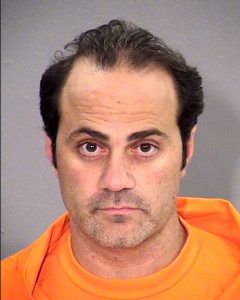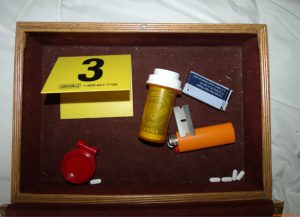- Slug: BC-CNS-Opioids Doctors,2,600
- Photos available (thumbnails, captions below)
- EDS: PLEASE RUN THE HOOKED PROMO PHOTO (below) OR THIS BOX WITH THIS STORY IF YOU PLAN TO PUBLISH PRIOR TO JAN. 10: Watch “Hooked Rx: From Prescription to Addiction,” a 30-minute commercial-free investigative report airing at 6:30 p.m. on Jan. 10 on 30 broadcast TV stations in Phoenix, Tucson and Yuma and 97 of the state’s radio stations. For the full report, go to hookedrx.com.
Eds: Because of an error in the editing process, a previous version of this story misstated information about Tucson’s Robert C. Osborne, who was indicted in December 2014. He has pleaded not guilty. The story below has been corrected, but clients who used earlier versions of this story are asked to run the correction that can be found here.
By AGNEL PHILIP and EMILY L. MAHONEY
Cronkite News
PHOENIX – One patient, a 29-year-old woman, was prescribed a dangerous cocktail of anti-anxiety drugs and opioids by her Fort Mohave doctor after a car accident. Another, this time a 61-year-old man with back pain, was given a potentially fatal dose of painkillers, including fentanyl, an opiate 30 to 50 times stronger than heroin.
Nearly five years after his first documented instance of overprescribing, the doctor’s medical license was suspended in August by the Arizona Medical Board. Three months later in November, authorities arrested him in Wyoming for allegedly prescribing an illegal amount of opioids to residents of five states, according to a complaint filed with the Wyoming’s U.S. District Attorney’s Office.
In Yuma, a doctor was forced to surrender his license last year after prescribing large quantities of controlled substances, including narcotic pain and anti-anxiety medications to a patient who died of drug and alcohol toxicity. The prescribing “continued until her death,” records show.
Although the number of doctors and physician assistants sanctioned for overprescribing opiates – just 250 during the past 16 years – is small compared to the more than 19,000 currently licensed to prescribe controlled substances, the boards’ disciplinary records detail more than 1,000 instances of overprescribing, sometimes after the doctor received multiple reprimands. In the most egregious cases, doctors prescribe opiates like OxyContin, Vicodin, Percocet, Dilaudid and others en masse for profit, often without performing any medical exams.
It can take years for a physician to be penalized and revocations are rare, according to a Cronkite News examination of hundreds of disciplinary records from the Arizona Medical Board, Arizona Board of Physician Assistants and the Arizona Board of Osteopathic Examiners. In the meantime, many of these physicians continue to practice.
“What I’d say to doctors is make sure that you understand the facts on these incredible products and make sure that they’re getting to the people that need them, that we’re avoiding it if someone has already beat addiction, or is an alcoholic and is a substance abuser, that we’re asking the right questions,” Arizona Gov. Doug Ducey said.
“And to the doctors who are abusing these products and are a part of these drug dealers that are trying to use the law or a regulation, that are trying to run cover for them, not only are we going to fix that, but we are going to find you as well.”
Cronkite News conducted a four-month investigation into the rise of prescription opioid abuse in Arizona. Dozens of journalists at Arizona State University examined thousands of records and traveled across the state to interview addicts, law enforcement, public officials and health care experts. The goal: uncover the root of the epidemic, explain the ramifications and provide solutions.
Since 2010, more than 3,600 people have overdosed and died from opioids in Arizona. In 2015, the dead numbered 701 – the highest of any year before, or nearly two per day, according to an analysis by the Arizona Department of Health Services.
Experts say the opioid epidemic is not limited to doctors who intentionally overprescribe potent painkillers. Just last year, U.S. Surgeon General Vivek H. Murthy issued a national report calling for a “cultural shift in how we think about addiction,” urging doctors and health care providers to be more diligent when prescribing dangerous drugs even to patients who may need them.
“A recent study found that doctors continue to prescribe opioids for 91 percent of patients who suffered a non-fatal overdose, with 63 percent of those patients continuing to receive high doses; 17 percent of these patients overdosed again within two years,” the report found.
Arizona has remained among the top states for the amount of oxycodone and morphine its pharmacies, hospitals and doctors have purchased per person since the Drug Enforcement Administration began publishing data in 2000. In 2015, more than 2 million grams of oxycodone alone came into the state, the third-highest total per capita in the country.
The state boards that regulate and license doctors in Arizona rely almost entirely on complaints from concerned residents or patients’ families members. Patricia McSorley, executive director of the Arizona Medical Board and Arizona Board of Physician Assistants – which regulate most medical doctors and all physician assistants in the state – declined to be interviewed for this story.
Jenna Jones, executive director of the Arizona Board of Osteopathic Examiners, which regulates the state’s 3,200 doctors of osteopathy, said the board is trying to help its doctors detect potential addicts before prescribing drugs.
“The opioid prescribing problem is not limited to one area,” she said. “It’s just something that’s hard to get your hands on. We’re trying to give doctors ideas of how to recognize drug-seeking behavior and how to deal with that.”
Dr. Shakeel Kahn, the Fort Mohave doctor arrested in November, spent years openly disputing his prescribing methods with local pharmacies while he continued to dole out pills with little action from the Arizona Medical Board. He sent letters to pharmacies in 2012 demanding that they fill his prescriptions for powerful opiate painkillers or prepare for a lawsuit.
Kahn made good on his promise, suing two pharmacies and pharmacists, one of whom called Kahn a “quack” who was “contributing to drug abuse in the Bullhead City area,” according to court documents.
He lost both lawsuits.
At the time, the medical board sent Kahn a “non-disciplinary” advisory letter, saying his record keeping was questionable for several patients who were prescribed several opioids. Until recently, his only formal sanction was in 2010 for an alleged patient abandonment case in which he increased doses of Dilaudid, an opioid, even though she was already “lethargic and sleepy,” possibly causing her to develop “pneumonia with acute respiratory failure while hospitalized,” records show.
At the height of their treatment with Kahn, two of his patients were taking the equivalent of 3,032 and 1,820 milligrams of morphine per day. A report by the Centers for Disease Control and Prevention discouraged doctors from prescribing more than 90 milligrams daily because of a high risk of a fatal overdose.
Kahn’s clinic, located in a strip mall across State Route 95 from Valley View Medical Center in Fort Mohave, had no markings but for a piece of paper taped to the inside of the door displaying operating hours, a phone number to call for appointments and a warning that he did not accept walk-ins. His attorney Thomas Price refused to comment, citing “ongoing legal proceedings.”
The Arizona State Board of Pharmacy maintains a database of doctors, patients and prescriptions called the Controlled Substances Prescription Monitoring Program, which can aid in physician disciplinary investigations. But state law prevents the boards from using it without an open investigation.
The DEA also has a database that can track prescription drugs from manufacturer to patient, but it isn’t typically used as a source of tips for criminal investigations because of the volume of drugs that it tracks, said Doug Coleman, the DEA special agent in charge of the Phoenix division, which oversees controlled substance registrations for tens of thousands of health professionals in Arizona.
“Unless someone gives us a tip, the chance of us finding (a doctor who is mishandling medication) from a regular regulatory inspection are remote,” Coleman said. “There are just so many more of them than there are of us, so it make take three to four years before we figure it out.”
Sometimes overprescribing doctors, like Tucson’s Robert C. Osborne, are criminally charged. He was indicted in December 2014 after allegedly prescribing hundreds of milligrams of opioids to his patients and fraudulently billing Medicare for pills his patients didn’t need. He has pleaded not guilty.
One of these patients was a 52-year-old Tucson nurse who had been an addict for years. Her dosages kept increasing under Osborne – even when she failed drug tests, records show. She was found dead in 2010, with four different medications in her blood.
“She was prescribed fentanyl patches, and those were the ones that she abused. Instead of putting them on her skin, she would chew them,” said the woman’s daughter, Jamie Dutton, 38. “I was lectured by all the pharmacists and all the pharmacy technicians. I was told when I picked her medications up or when I dropped off the prescriptions, they felt that she was being overprescribed and it was reported to the DEA.”
Osborne’s case is pending.
Deaths by opioid overdoses in Arizona, which include heroin, have increased from about 620 in 2014 to 701 in 2015, according to the Arizona Department of Health Services. Thousands of drug users required emergency room care after an overdose.
So-called “pill mills,” where doctors like Osborne allegedly exchanged cash for pills, are investigated by law enforcement just as they would investigate an illegal drug ring. Those, too, take time.
“In Arizona, there are millions and millions of pills that make their way into our communities. Many of these pills are highly addictive,” said Stephen Duplissis, section chief for the Health Care Fraud and Abuse section of the Arizona Attorney General’s Office. “So we have to think about, how did these pills, these highly addictive pills, make their way into Arizona communities? Well, one way they make their way into Arizona communities is when we have a doctor that’s willing to prescribe drugs for no legitimate medical purpose, but simply for profit.”
“What we have is a society that is functioning day in and day out, and they’re high,” Duplissis said.
The Arizona Medical Board had prohibited Alaaeldin Babiker, the Yuma doctor who surrendered his license in April after his patient died, from prescribing controlled substances two years earlier. He was disciplined for opioid dependence, among other addictions, and for prescribing drugs to his wife.
When board officials went to his office, patients filled the waiting room and he was nowhere to be found. There were “used syringes, needles, dirty cotton balls and other unsanitary materials strewn on the floor and on desks,” disciplinary records show.
Unlike Babiker, some overprescribing doctors are disciplined multiple times without lasting restrictions on their license.
One physician in Casa Grande, Michael Ridge, prescribed a mixture of Vicodin and other drugs for years to a 20-year-old patient, who the doctor noted was “craving opioids,” records show. The man made three suicide attempts while in the doctor’s care, one of which was reported by his mother.
About a year after the man’s first appointment, Ridge “received notice from a pharmacy that (the man) was receiving controlled substances from other providers.” After briefly cutting him off, Ridge continued his prescriptions.
The Arizona Medical Board reprimanded Ridge without restrictions, finding that he “prescribed narcotics for chronic pain without performing an evaluation of the pain problem.” He was later put on probation for similar offenses. Ridge did not respond to requests for comment. He still is practicing.
One osteopathic doctor, Richard Settles, traveled to multiple states, lying on license applications and trying to prescribe opioids until his DEA registration was revoked in September. But the pattern began in Arizona, where he distributed opioids en masse until a patient’s mother complained to the board, causing Settles to voluntarily surrender his DEA prescribing registration.
Three months later, an anonymous tip alerted to the osteopathic board claimed he was still prescribing. The board found he had issued 17 prescriptions for controlled substances, including morphine and oxycodone, to hospice patients after he lost his registration.
Jones, of the osteopathic board, said educating the public about the board’s role in disciplining doctors will allow it to catch offenses more quickly.
“The family members usually know right up front and are the first to know about a situation,” she said. “Those are things we want to hear about. Those are the situations we want to be made aware of.”
Like the medical board, the osteopathic board has also given overprescribing doctors multiple chances and failed to catch others for years.
Philo Rogers, an osteopathic doctor, was disciplined six times over 14 years – the most for any doctor – for providing excessive opioid prescriptions with too little medical documentation. Rogers did not respond to requests for comment.
Prescription drug addiction “is not getting the attention it so desperately needs to save lives. And a big component to that is that we classify certain drugs as OK, and certain drugs as not OK,” said 21-year-old Marissa Rodriguez, whose addiction started when she was 14 with OxyContin after a gymnastics injury. “It’s going into suburban America, it’s getting to kids younger, and younger, and younger, because it’s OK somehow and that needs to change.”
Sabrina Pojar, a faculty doctor at the Banner – University Medical Center in Phoenix, previously worked at a Phoenix family medicine clinic where her predecessor prescribed high doses of opioids. Pojar said some patients also were taking anti-anxiety drugs or had respiratory conditions that made a deadly overdose more likely.
Sometimes, she said, she gives patients an ultimatum: Taper off your opioid use or go to a clinic that specializes in pain management.
“It’s a hard situation to be in, because you want to help people and it’s hard to know when you meet someone for the first time if they’re already addicted to these medications and finding that middle ground where I know I’m helping them and that they’re satisfied with their health care,” she said. “There were some patients that got angry, some threatened. In the end I felt I was doing the right thing, because I took an oath not to cause harm first and foremost.”
The DEA’s Coleman said doctors who overprescribe opioids typically fall into two categories: rogue doctors and physicians who succumb to pressure from patients, and pharmaceutical companies.
“Most of these guys and gals are 100 percent legit,” he said. “They’re doing it exactly the way they were trained. They care about their patients. But if you have one that’s after the profit, he can write (200 to) 300 prescriptions a day. Those are criminal doctors. Those are the drug dealers. But the reason that they’re the problem is they can wreak so much havoc.”
One of those rogue doctors was Edward Sayegh, who was sentenced to four years in prison after pleading guilty last year to multiple charges including conspiracy, fraud, and drug diversion charges. According to court records, Sayegh was not only prescribing opioids without medical cause, he also was abusing narcotics himself. He ran an extensive prescription drug ring that involved making deals with drug traffickers exchanging painkillers for prostitutes.
“If we look at the former doctor Edward Sayegh, guestimation was 200,000 pills on an annual basis,” Duplissis said. “And the date range for that case was from August 2009 all the way into April of 2014. So you do the math on that, and that’s a lot of pills.”
Sayegh declined to be interviewed through a Arizona Department of Corrections spokesman.
“The best attorneys are hired for doctor’s cases. They have funds at their disposal so we go up against the best criminal defense attorneys in the Arizona when we charge a doctor case,” Duplissis said.
“When we charge a doctor case we are ready for war,” he later added.
Osborne, the former Tucson doctor, had his license revoked a few months before his indictment in 2014, four years after he started overprescribing and two years after a Tucson rehab center filed a complaint to the Arizona Medical Board about him. He had already been reprimanded in 2009 for opioid overprescribing.
Osborne has pleaded not guilty. He has yet to go to trial, but Dutton said criminal prosecution can only do so much.
“He can go to prison, but we’re never going to have our mother back,” she said. “It caused a whirlwind of addiction in my family. And it just kind of turned the wheel, and we lost another family member and it just should’ve never happened.”
Cronkite News reporter Lily Altavena contributed to this article.
^__=
Arizona has sanctioned 250 doctors and physician assistants for overprescribing prescription pain pills during the past 16 years. (Photo by Johanna Huckeba/Cronkite News)
Addicts who overdose on prescription painkillers often end up in the emergency room. (Photo by Johanna Huckeba/Cronkite News)
Since 2009, there have been more than 14,500 cases of heroin and opioid overdoses in emergency rooms across the state. (Photo by Johanna Huckeba/Cronkite News)
Edward Sayegh was sentenced to four years in prison after pleading guilty last year to multiple charges including conspiracy, fraud and drug diversion charges. (Photo courtesy of Arizona Attorney General’s Office)
Authorities suspect a Show Low pharmacist of stealing more than 3,000 doses of oxycodone, hydrocodone and other drugs. She was indicted in May. The Navajo County Sheriff’s Office Major Crimes Apprehension Team, the Show Low Police Department and special agents with the Arizona Attorney General’s Office Special Investigations Section conducted the investigation. (Photo courtesy of the Arizona Attorney General’s Office)
Authorities suspect a Show Low pharmacist of stealing more than 3,000 doses of oxycodone, hydrocodone and other drugs. She was indicted in May. The Navajo County Sheriff’s Office Major Crimes Apprehension Team, the Show Low Police Department and special agents with the Arizona Attorney General’s Office Special Investigations Section conducted the investigation. (Photo courtesy of the Arizona Attorney General’s Office)
Authorities suspect a Show Low pharmacist of stealing more than 3,000 doses of oxycodone, hydrocodone and other drugs. She was indicted in May. The Navajo County Sheriff’s Office Major Crimes Apprehension Team, the Show Low Police Department and special agents with the Arizona Attorney General’s Office Special Investigations Section conducted the investigation. (Photo courtesy of the Arizona Attorney General’s Office)
Authorities suspect a Show Low pharmacist of stealing more than 3,000 doses of oxycodone, hydrocodone and other drugs. She was indicted in May. The Navajo County Sheriff’s Office Major Crimes Apprehension Team, the Show Low Police Department and special agents with the Arizona Attorney General’s Office Special Investigations Section conducted the investigation. (Photo courtesy of the Arizona Attorney General’s Office)
Authorities suspect a Show Low pharmacist of stealing more than 3,000 doses of oxycodone, hydrocodone and other drugs. She was indicted in May. The Navajo County Sheriff’s Office Major Crimes Apprehension Team, the Show Low Police Department and special agents with the Arizona Attorney General’s Office Special Investigations Section conducted the investigation. (Photo courtesy of the Arizona Attorney General’s Office)
Authorities suspect a Show Low pharmacist of stealing more than 3,000 doses of oxycodone, hydrocodone and other drugs. She was indicted in May. The Navajo County Sheriff’s Office Major Crimes Apprehension Team, the Show Low Police Department and special agents with the Arizona Attorney General’s Office Special Investigations Section conducted the investigation. (Photo courtesy of the Arizona Attorney General’s Office)
Arizona Department of Health Services numbers have documented thousands of emergency room overdoses over the last six years. (Photo by Johanna Huckeba/Cronkite News)











